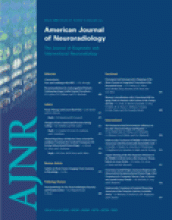Abstract
BACKGROUND/PURPOSE: Identification of carotid near-occlusion is essential before calculation of percent stenosis because stroke risk is lower than other severe stenosis and the treatment benefit is less. Calculations with reduced distal diameters are fallacious. CT angiography (CTA) is convenient and accurately quantifies internal carotid artery (ICA) stenosis.
METHODS: In a blinded protocol, 268 carotid artery CTAs for known or suspected carotid disease were independently evaluated by 2 neuroradiologists. All carotid arteries were measured in millimeters at the narrowest diameter of the stenotic bulb, distal ICA well beyond the tapering bulb, and distal external carotid artery (ECA). Near-occlusions were independently identified, with disagreements settled by consensus meeting. Receiver operating characteristic (ROC) curve analysis defined the threshold values that best predicted near-occlusion according to (1) ICA stenosis, (2) distal ICA, (3) distal ICA: contralateral distal ICA, and (4) distal ICA: ECA. Paired permutations of variables were evaluated.
RESULTS: Forty-two near-occlusion distal ICAs were identified. The ROC-derived threshold values determined near-occlusion carotid stenosis with a sensitivity range, 90.2–97.3; specificity, 84.1–89.9; positive predictive value (PPV), 61.3–66.7; and negative predictive value (NPV), 96.7–99.4. Ranges for paired permutations were also determined: sensitivity, 82.9–91.9; specificity, 95.4–96.8; PPV, 78.6–85.7; and NPV, 96.3–98.4.
CONCLUSIONS: Threshold values provide guidelines for CTA interpretation when assessing carotid artery disease and the presence of near-occlusion. Ultimate identification of near-occlusion requires the interpreter’s judgment, with attention to the following criteria: (1) notable stenosis of the ICA bulb and (2) distal ICA caliber reduction compared with (A) expected size, (B) contralateral ICA, and (C) ipsilateral ECA. Near-occlusion distal ICAs can be reliably identified on CTA.
- Copyright © American Society of Neuroradiology












